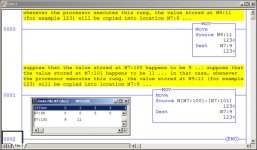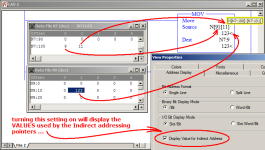i'm trying to understand how the instruction is operating to get the value in the destination.
consider the two rungs shown below ... do you fully understand the operation of the first rung? ...
if the answer is yes, let's move on to the second rung ...
as long as the "pointers" N7:100 and N7:101 have the EXACT values mentioned (9 and 11) then the operation of the second rung will be precisely the same as the operation of the first rung ...
in other words, these two rungs will operate EXACTLY THE SAME – as long as the pointers have the specific values that I've shown ...
here's the reason for using this INDIRECT addressing technique ...
the first MOV is "FIXED" ... specifically it will ALWAYS get its Source value from the integer location N9:11 ...
but ...
the second MOV can be "RE-AIMED" ... specifically, we can tell the processor to get the Source value from ANY valid integer location – just by plugging different values into the "pointers" ...
the "pointer" N7:100 tells the MOV command which FILE NUMBER to get its Source from ... (example: FILE number 9) ...
the "pointer" N7:101 tells the MOV command which WORD NUMBER to get its Source from ... (example: WORD number 11) ...
if this doesn't nail it down for you, get some sleep and call me tomorrow afternoon ... I'll talk you through it over the phone ...
.







